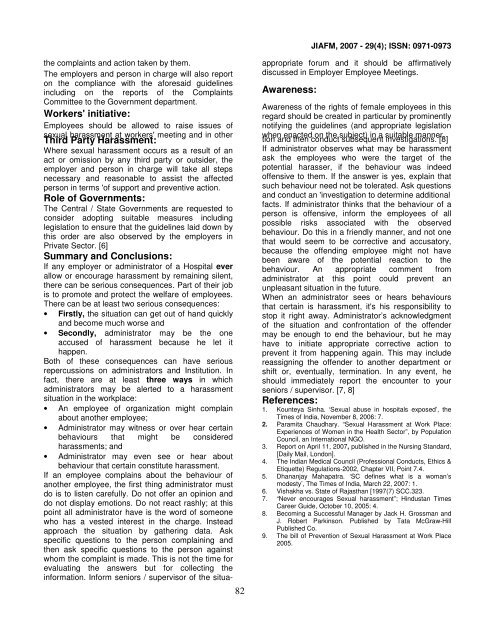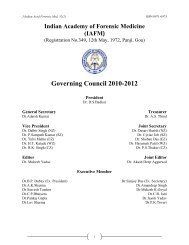Download - forensic medicine
Download - forensic medicine
Download - forensic medicine
Create successful ePaper yourself
Turn your PDF publications into a flip-book with our unique Google optimized e-Paper software.
JIAFM, 2007 - 29(4); ISSN: 0971-0973<br />
the complaints and action taken by them.<br />
The employers and person in charge will also report<br />
on the compliance with the aforesaid guidelines<br />
including on the reports of the Complaints<br />
Committee to the Government department.<br />
Workers' initiative:<br />
Employees should be allowed to raise issues of<br />
sexual harassment at workers' meeting and in other<br />
82<br />
appropriate forum and it should be affirmatively<br />
discussed in Employer Employee Meetings.<br />
Awareness:<br />
Awareness of the rights of female employees in this<br />
regard should be created in particular by prominently<br />
notifying the guidelines (and appropriate legislation<br />
when enacted on the subject) in a suitable manner.<br />
Third Party Harassment:<br />
Where sexual harassment occurs as a result of an<br />
act or omission by any third party or outsider, the<br />
employer and person in charge will take all steps<br />
necessary and reasonable to assist the affected<br />
person in terms 'of support and preventive action.<br />
Role of Governments:<br />
The Central / State Governments are requested to<br />
consider adopting suitable measures including<br />
legislation to ensure that the guidelines laid down by<br />
this order are also observed by the employers in<br />
Private Sector. [6]<br />
Summary and Conclusions:<br />
If any employer or administrator of a Hospital ever<br />
allow or encourage harassment by remaining silent,<br />
there can be serious consequences. Part of their job<br />
is to promote and protect the welfare of employees.<br />
There can be at least two serious consequences:<br />
• Firstly, the situation can get out of hand quickly<br />
and become much worse and<br />
• Secondly, administrator may be the one<br />
accused of harassment because he let it<br />
happen.<br />
Both of these consequences can have serious<br />
repercussions on administrators and Institution. In<br />
fact, there are at least three ways in which<br />
administrators may be alerted to a harassment<br />
situation in the workplace:<br />
• An employee of organization might complain<br />
about another employee;<br />
• Administrator may witness or over hear certain<br />
behaviours that might be considered<br />
harassments; and<br />
• Administrator may even see or hear about<br />
behaviour that certain constitute harassment.<br />
If an employee complains about the behaviour of<br />
another employee, the first thing administrator must<br />
do is to listen carefully. Do not offer an opinion and<br />
do not display emotions. Do not react rashly; at this<br />
point all administrator have is the word of someone<br />
who has a vested interest in the charge. Instead<br />
approach the situation by gathering data. Ask<br />
specific questions to the person complaining and<br />
then ask specific questions to the person against<br />
whom the complaint is made. This is not the time for<br />
evaluating the answers but for collecting the<br />
information. Inform seniors / supervisor of the situation<br />
and then conduct subsequent investigations. [8]<br />
If administrator observes what may be harassment<br />
ask the employees who were the target of the<br />
potential harasser, if the behaviour was indeed<br />
offensive to them. If the answer is yes, explain that<br />
such behaviour need not be tolerated. Ask questions<br />
and conduct an 'investigation to determine additional<br />
facts. If administrator thinks that the behaviour of a<br />
person is offensive, inform the employees of all<br />
possible risks associated with the observed<br />
behaviour. Do this in a friendly manner, and not one<br />
that would seem to be corrective and accusatory,<br />
because the offending employee might not have<br />
been aware of the potential reaction to the<br />
behaviour. An appropriate comment from<br />
administrator at this point could prevent an<br />
unpleasant situation in the future.<br />
When an administrator sees or hears behaviours<br />
that certain is harassment, it's his responsibility to<br />
stop it right away. Administrator’s acknowledgment<br />
of the situation and confrontation of the offender<br />
may be enough to end the behaviour, but he may<br />
have to initiate appropriate corrective action to<br />
prevent it from happening again. This may include<br />
reassigning the offender to another department or<br />
shift or, eventually, termination. In any event, he<br />
should immediately report the encounter to your<br />
seniors / supervisor. [7, 8]<br />
References:<br />
1. Kounteya Sinha. ‘Sexual abuse in hospitals exposed’, the<br />
Times of India, November 8, 2006: 7.<br />
2. Paramita Chaudhary. “Sexual Harassment at Work Place:<br />
Experiences of Women in the Health Sector”, by Population<br />
Council, an International NGO.<br />
3. Report on April 11, 2007, published in the Nursing Standard,<br />
[Daily Mail, London].<br />
4. The Indian Medical Council (Professional Conducts, Ethics &<br />
Etiquette) Regulations-2002, Chapter VII, Point 7.4.<br />
5. Dhananjay Mahapatra. ‘SC defines what is a woman’s<br />
modesty’, The Times of India, March 22, 2007: 1.<br />
6. Vishakha vs. State of Rajasthan [1997(7) SCC.323.<br />
7. “Never encourages Sexual harassment”; Hindustan Times<br />
Career Guide, October 10, 2005: 4.<br />
8. Becoming a Successful Manager by Jack H. Grossman and<br />
J. Robert Parkinson. Published by Tata McGraw-Hill<br />
Published Co.<br />
9. The bill of Prevention of Sexual Harassment at Work Place<br />
2005.




![syllabus in forensic medicine for m.b.b.s. students in india [pdf]](https://img.yumpu.com/48405011/1/190x245/syllabus-in-forensic-medicine-for-mbbs-students-in-india-pdf.jpg?quality=85)



![SPOTTING IN FORENSIC MEDICINE [pdf]](https://img.yumpu.com/45856557/1/190x245/spotting-in-forensic-medicine-pdf.jpg?quality=85)

![JAFM-33-2, April-June, 2011 [PDF] - forensic medicine](https://img.yumpu.com/43461356/1/190x245/jafm-33-2-april-june-2011-pdf-forensic-medicine.jpg?quality=85)



![JIAFM-33-4, October-December, 2011 [PDF] - forensic medicine](https://img.yumpu.com/31013278/1/190x245/jiafm-33-4-october-december-2011-pdf-forensic-medicine.jpg?quality=85)

